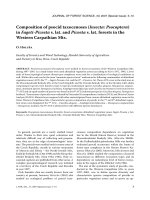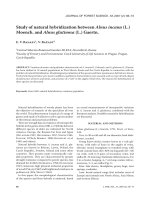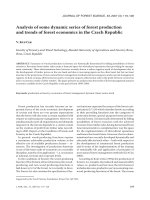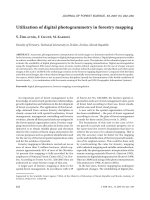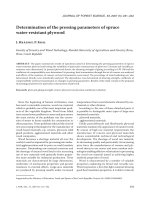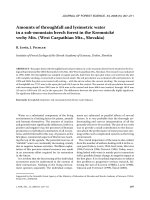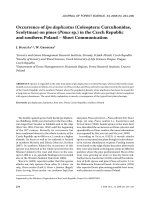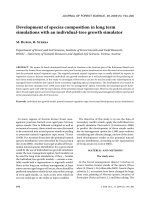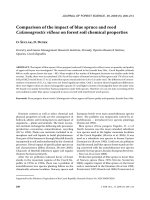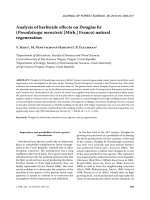Báo cáo lâm nghiệp: "Evaluation of squared timber and log products in the Hyrcanian Forests of Iran" doc
Bạn đang xem bản rút gọn của tài liệu. Xem và tải ngay bản đầy đủ của tài liệu tại đây (560.43 KB, 6 trang )
64 J. FOR. SCI., 57, 2011 (2): 64–69
JOURNAL OF FOREST SCIENCE, 57, 2011 (2): 64–69
Evaluation of squared timber and log products
in the Hyrcanian Forests of Iran
S. M. H
1
, B. M
2
, A. S
3
1
Ministry of Science, Research and Technology, Tehran, Iran,
2
Faculty of Natural Resources, University of Tehran, Tehran, Iran
3
Department of Forest and Forest Products Technology, Mendel University in Brno,
Brno, Czech Republic
ABSTRACT: The forests located in the northern areas of Iran are known as Hyrcanian Forests and are distributed
across three provinces, namely Gilan, Maznadarn and Golestan. These provinces are situated in the north of Iran
near the Caspian Sea. Timber products in the said forests during the last two decades were markedly different so that
the total timber harvested in the first decade was 1.6 million m
3
on average, however, in the second decade it nearly
amounted to 1 million m
3
. Two major timber products of Iran are studied and compared in this research, namely
logs and squared timber. Squared timber products averaged 10.7% during the first decade, but they fell to 7.3% over
the second decade. Apropos of log products, they reached 20.9% and 29.2% over the first and the second decade, re-
spectively. Analyses of the data indicate the following converse linear equation between squared timber products and
log products during the 20 years of study: Y =–0.359X + 18.065 (Y = log products, X = squared timber, R
2
= 0.768).
Accordingly, any increase in log products at a time caused the squared timber products to decrease at the same time.
Keywords: Hyrcanian Forests; logs; mechanized harvesting system; squared timber
e Hyrcanian Forests of Iran are natural broad-
leaved forests located in the north of Iran near the
Caspian Sea (Fig. 1). ey have uneven topography
and very steep slopes so that these regions with
slopes larger than 100% have been designated as the
protected areas, where harvesting operations are
banned. Due to the ecosystemic and environmen-
tal aspects, biodiversity, ecology and eco-tourism
values and their historical background, these for-
ests are one of the important ecological resources
in the world. e average standing timber volume
is about 210 m
3
·ha
–1
, an average of 201 trees per
hectare canopies are shown in Table 1.
For many diff erent reasons such as socio-eco-
nomic situation, export and import of wood and
timber market, the trend of timber products in
these forestlands has not been so regular during the
last 20 years. e main types of timber products in
these forests are logs, squared timber, sawlogs, fuel
wood and charcoal (Table 2).
Fig. 1. Study site location
Supported by the Ministry of Education, Youth and Sport of the Czech Republic, Project No. MSM 6215648902, and
by the Ministry of Agriculture of the Czech Republic, Project No. QH71159.
J. FOR. SCI., 57, 2011 (2): 64–69 65
Harvesting operations in these forest zones are
divided into two categories: non- mechanized and
mechanized logging systems. In non-mechanized
logging systems, after cutting, felling and delimb-
ing, the logs are cut using manual chainsaws into
smaller products such as squared timber, sawlogs
and so on in forest stands. en these smaller
products are dragged by animals like horses, don-
keys and mules (Fig. 2). In mechanized systems,
cutting and bucking operations are carried out
by manual chainsaws; however, logs are extracted
by skidders from forest stands to a yard near the
main road (Fig. 3). As K (2007) indicated,
from 1997 to 2002 the importation of timber to
Iran increased and its exportation decreased dur-
ing the same period. S (2000) showed
that the amounts of squared timber importation
to Iran increased during the last 10 years. H-
et al (2008) reported that the importation of
squared timber to Iran experienced an increase of
over 100% from 2000 to 2008 in comparison with
the years between 1989 and 1999. e total log
volume imported to Iran since 1989 has been less
than 1% in total. is information, together with
other references, showed that other factors also in-
fl uenced the production of logs and squared tim-
ber in these forestlands (S 1990; A-
2005; Anonymous 2006). For instance,
over the fi rst decade under study, only 30% of har-
vesting operations were carried out using mecha-
nized systems, while during the second decade,
their use increased to 70% (H et al. 2009).
e unit cost per cubic meter of squared timber
compared with skidding systems was exorbitantly
high; therefore, the local contractors and timber
sellers were encouraged to produce logs instead of
squared timber (S 1990).
is paper is aimed at shedding light on the pro-
cesses and trends of squared timber and log pro-
duction and the relations between them in the Hyr-
canian Forests of Iran during the last 20 years.
MATERIALS AND METHODS
Areas under Study
Located in the northern part of Iran, the study
areas are known as the Northern Forests or Hyr-
canian Forests and are distributed across three
provinces: Golestan, Mazandaran, and Gilan. e
majority of these forests are located in Mazandaran
Province with 967,790 ha (51%), Gilan with 511,306
ha (27%) and Golestan with 421,905 (22%). ese
forests form rather a narrow green belt bordering
the northern part of the Alborz Mountains and ex-
tend from Astara in the west of Gilan Province to
Giledarreh in the east of Golestan province, and are
about 800 km in length and 20 to 70 km in width
(Fig. 1).
Methodology
In this study, all documents of trees cut dur-
ing the last 20 years in the three provinces under
study have been examined, summarized, and cat-
Table 1. Canopies of trees in the Northern Forests of
Iran
Situation
Close
forests
Semi closed
forests
Open
forests
Canopy cover
(%)
51 32 17
Table 2. Total volume and percentage of timber products in the Hyrcanian Forests of Iran
Log Squared Timber Sawlog Fuel Wood Charcoal
1989 2008 1989 2008 1989 2008 1989 2008 1989 2008
Volume 97,392 34,058 119,531 53,437 224,893 231,350 673,011 309,530 271,566 4,884
Percentage 15.2 34.8 7.5 5.8 14.2 25.1 42.6 33.6 17.2 0.5
Fig. 2. Extracting squared timbers by animals
66 J. FOR. SCI., 57, 2011 (2): 64–69
egorized based on the type of timber products. e
production processes of two major categories, i.e.
squared timber and logs, were studied per province
separately.
e volume of squared timber was calculated
through measuring the length, width and height.
Such timbers were extracted out of forest stands
using the animals like horses and mules in such a
way that each animal carried two logs per load and
one end of timbers was dragged along the ground
(Fig. 2). e volume of logs was gauged based on
the Huber formula and measuring the lengths and
middle diameters of logs and the logs were extract-
ed by skidders (Fig. 3). Furthermore, the processes
of forest harvesting systems progress in the study
areas were monitored at the same time. e rela-
tionships between squared timber and log prod-
ucts during the last 20 years (1989–2008) were
evaluated using statistical software such as SPSS
(Statistical Package for Social Sciences) and so on.
RESULTS
e total squared timber volume produced from
1989 to 2008 in the three northern provinces of
Iran, namely Golestan, Mazandaran and Gilan, was
439,715 m
3
, 1,709,655 m
3
and 363,101 m
3
, respec-
tively (Table 3). e maximum volume of 76,959 m
3
was produced in Golesan forests in 1991, in Ma-
zandaran forests it was 139,217 m
3
in 1990 and in
Gilan forests it was 29,360 m
3
in 2002. is table
also shows that the squared timber products at all
three forest sites had a downward trend during the
last two decades; however, this trend was is not
quite regular on a year-by-year basis.
Fig. 3. Extracting logs by skidders
Table 3. Total squared timber and log products in the study areas in zears 1989–2008
Squared timber (m
3
) Logs (m
3
)
Provinces
Golestan Mazandaran Gilan Golestan Mazandaran Gilan
1989 35,204 124,450 8,872 13,269 131,168 96,178
1990 40,235 139,217 9,873 17,561 154,258 94,731
1991 76,959 125,199 13,985 13,501 155,934 111,634
1992 31,663 123,956 16,072 13,298 183,439 123,240
1993 28,692 138,238 15,918 15,277 196,770 111,853
1994 22,848 131,489 15,867 43,611 218,441 149,808
1995 19,187 137,121 20,351 39,666 214,485 141,560
1996 25,461 105,331 28,365 36,662 201,299 138,444
1997 20,485 97,188 26,503 46,412 208,135 116,561
1998 18,758 99,097 23,126 45,874 231,774 131,469
1999 20,115 94,415 14,436 60,162 194,328 86,486
2000 20,046 61,710 14,806 32,399 170,747 90,935
2001 18,162 57,243 27,009 22,309 189,649 107,158
2002 13,974 43,494 29,360 24,973 201,807 99,019
2003 5,169 41,691 18,956 15,773 213,414 86,758
2004 11,581 45,384 22,338 9,067 214,814 76,572
2005 9,530 41,265 17,142 12,618 204,319 56,694
2006 9,287 35,729 16,791 11,233 193,641 53,559
2007 6,071 31,172 12,448 13,232 205,233 66,922
2008 6,288 36,266 10,883 18,212 228,033 74,104
Total 439,715 1,709,655 363,101 505,109 3,911,688 2,013,685
J. FOR. SCI., 57, 2011 (2): 64–69 67
e maximum of log products in Golestan, Ma-
zandaran and Gilan forestlands was 60,162 m
3
(1999), 231,774 m
3
(1998) and 149,808 m
3
(1994),
respectively. e log products in the three forest-
lands vis-à-vis the squared products had an upward
trend, and such a trend increased several times
in comparison with the early years of the studied
period.
e data collected from the total timber products
at the three sites under study during the last 20 years
shows that in the fi rst decade (1989–1998) there was
not a large diff erence in the volumes of products,
however, during the second period (1999–2008) it
gradually decreased so that in 1998 it was 1.7 million
m
3
and in 2008 it reached 0.9 m
3
(Fig. 4). As all these
forestlands are state forests, the government tries
to reduce logging operations and preserve them for
future generations. At the moment, the most fre-
quently used types of machines are skidders which
are generally imported from abroad.
e average share of squared timber products in
the fi rst decade was 10.7% and in the second de-
cade it was 7.3%; meanwhile the share of log prod-
ucts was 20.9% and 29.2% in the fi rst and second
decade, respectively.
Data analysis indicated that simultaneously with
the increase in the total timber production during
the studied period, the squared timber production
in percentage declined (Fig. 5a), but the percent-
age of log products increased at the same time
(Fig.5b). In other words, with the reduction of to-
tal timber products in these forests the quality of
products also changed to positive improvements
such as log products. Furthermore, it should be
noted that other contributory factors probably af-
fected this process and trend, for example the wood
market, introduction of new mechanized harvest-
ing systems, new wood technology and industries,
imports and exports of timbers and so on (H-
et al. 2008).
Data analysis shows that there is a signifi cant cor-
relation between log products and squared timbers
and this is a converse linear relationship. e math-
ematical equation between the two mentioned fac-
tors is as follows:
Y = –0.359X + 18.065
R
2
= 0.768
Y = log products
X = squared timber
e results of nonparametric tests, which were
obtained using SPSS software, confi rmed a sig-
nifi cant correlation between the log products and
squared timber on both statistical levels of 1% and
5% (Table 4).
CONCLUSION
As the acquired data showed, total timber prod-
ucts in the three provinces of study for the fi rst 10
years of study were approximately close to each oth-
er while in the second 10 years of study they were
quite diff erent from the fi rst period. Data analysis
indicates that the percentages of squared timber
and log products are completely diff erent from each
other so that the scooter plots of log products are an
ascending curve and for squared timber it is a de-
scending curve (Fig. 5c). In other words, although
the total timber harvested decreased (Fig. 4), the
amounts of log products increased and the amounts
of squared timber declined at the same time.
As a result, this study shows that the amounts of
squared timber products in the Hyrcanian Forests
Fig. 4. Total timber products in the three
forest sites under study
Table 4. Summary of nonparametric output test for logs
and squared timber products during last 20 years
Situation No. of samples Kendall's tau_b P-value
Logs 20 –779 0/000
Squared
timber
20 –919 0/000
P – Probability
1989 1993 1998 2003 2008
Year
2,000
1,600
1,200
800
400
0
Volume (1,000 m
3
)
68 J. FOR. SCI., 57, 2011 (2): 64–69
Fig. 5. Percentages of (a) squared
timber (b) logs products and (c) log
products and squared timber in three
site study location during last 20 years
of Iran during the last 20 years were dependent
on log products. One of the main eff ective fac-
tors in this relationship was harvesting operations
changing from non-mechanized logging systems
to mechanized logging systems in the said forest-
lands. erefore, by improving the mechanized
logging operations, the log products increased and
squared timber decreased.
R e f e r e n c e s
A M. (2005): Wood and timber for future.
Harvesting and wood industries magazine. Tehran, Forest
Organization of Iran. 63–68.
Anonymous (2006): Timber Products, Consuming in Iran.
Annual reports of the Forest and Range Organization of
Iran. Tehran, Forest and Range Organization of Iran: 43–45.
K M. (2007): e study of import and exports of timbers
from the Iranian ports. [MSc. esis.] Tehran, University
of Tehran: 120–123.
H M., M B., A M. (2008): Final
report of the research project in titled: e study of rela-
tionship between timber products in Sari forestlands and
imported timbers. Tehran, University of Amirkabir: 90–93.
H M., M B., S A. (2009): Mechanized
logging systems and timber products in the Hyrcanian Forests
of Iran. In: Proceeding of Formec Meeting, International Sym-
posium on Forest Mechanization. Prague, 21.–24. June 2009.
Prague, Czech University of Life Sciences Prague: 182–185.
5
10
15
20
25
30
35
Golestan Forests
Mazandaran Forests
Gilan forests
0
5
10
15
20
25
30
35
Golestan Forests
Mazandaran Forests
Gilan forests
(a)
1989 1993 1998 2003 2008
Year
35
30
25
20
15
10
5
0
(%)
Golestan forest
Mazandar forests
Gilan forests
10
15
20
25
30
35
40
45
Golestan Forests
Mazandaran Forests
Gilan forests
0
5
10
15
20
25
30
35
40
45
Golestan Forests
Mazandaran Forests
Gilan forests
(b)
1989 1993 1998 2003 2008
Year
40
35
30
25
20
15
10
5
0
(%)
Golestan forest
Mazandar forests
Gilan forests
10
5
0
5
0
5
0
Squared timber
Logs
0
5
0
5
0
5
0
5
0
1989 1991 1993 1995 1997 999 01 03 2005 2007
Squared timber
Logs
(c)
1989 1993 1997 2001 2007
Year
40
35
30
25
20
15
10
5
0
(%)
Squared timber
Logs
J. FOR. SCI., 57, 2011 (2): 64–69 69
S N. (1990): Forest Harvesting. Tehran, University
of Tehran: 340–362.
S S. (1990): e study of forest harvesting and
timber importing to Iran. Tehran, Wood Industrial Offi ce
of the Forest organization of Iran: 28–30.
S H. (2000): Evaluating of quality and quantity of
importing timbers to Iran. [MSc. esis.] Tehran, Univer-
sity of Azad of Iran: 186–189.
Received for publication September 9, 2009
Accepted after corrections August 9, 2010
Corresponding author:
Doc. Ing. A S, CSc., Mendel University in Brno, Faculty of Forestry and Wood Technology,
Department of Forest and Forest Products Technology, Zemědělská 3, 613 00 Brno, Czech Republic
e-mail:
